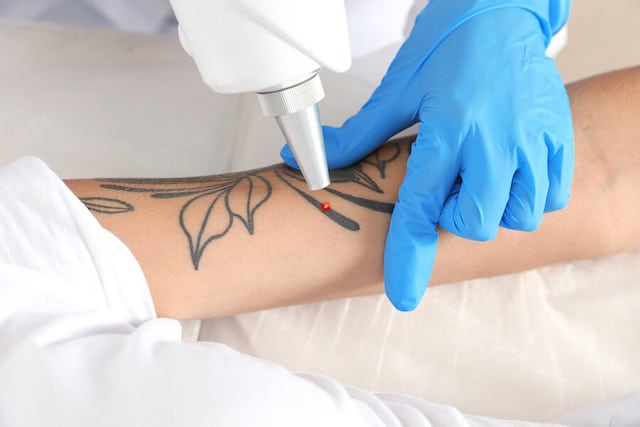Laser tattoo removal has become one of the most popular methods for removing unwanted tattoos. The procedure uses focused laser light to break down the ink pigments in the skin, allowing the body to naturally eliminate the particles. If you're considering laser tattoo removal in Dubai, it's essential to understand what happens to your skin during the process. This article explores the science behind laser Tattoo Removal Dubai and its effects on your skin.
How Laser Tattoo Removal Works
Laser tattoo removal utilizes highly concentrated light beams to target the tattoo ink beneath the skin's surface. The laser energy breaks down the ink particles into smaller fragments, which are then removed by the body's immune system. The skin reacts to the heat produced by the laser, leading to a series of biological processes that eventually result in the fading or complete removal of the tattoo.
Laser Penetration into the Skin
During the treatment, the laser penetrates the outer layers of your skin, delivering pulses of energy that are absorbed by the tattoo pigments. The laser wavelengths used are selected based on the color of the tattoo. Different wavelengths are absorbed by different ink colors, making it possible to target a wide range of tattoos.
Breakdown of Tattoo Ink
As the laser pulses are delivered to the tattoo, they break the ink particles into smaller pieces. The body's immune system then works to remove these fragmented ink particles over time. This process can take several weeks, with each treatment session contributing to the fading of the tattoo.
The Role of Your Skin's Natural Healing Process
After each session, your skin goes through a healing process. This is an essential part of the laser tattoo removal journey. The healing process varies depending on the intensity of the laser used, the tattoo's depth, and your skin's natural ability to recover.
Inflammatory Response
One of the first reactions your skin experiences after laser tattoo removal is an inflammatory response. The heat from the laser stimulates the skin's natural healing mechanisms, triggering an inflammatory reaction. This is a normal part of the healing process, as the skin works to repair itself.

Formation of Scabs
Following the laser treatment, small scabs may form over the treated area. These scabs are a result of the laser energy causing some superficial skin damage. As the scabs fall off, new, healthy skin begins to regenerate underneath. It's important not to pick or scratch these scabs, as doing so could interfere with the healing process.
Collagen Production and Skin Renewal
The heat from the laser also stimulates collagen production in the treated area. Collagen is a vital protein that helps the skin heal and regenerate. As the tattoo fades, the skin gradually renews itself, and the tattoo ink is gradually removed by your immune system. Over time, this process leads to the fading or elimination of the tattoo.
The Skin's Reaction to Laser Tattoo Removal
While laser tattoo removal is designed to target tattoo ink, it also affects the skin in various ways. The skin's response to the treatment can vary based on the tattoo's location, size, and your skin type.
Temporary Redness and Swelling
After the treatment, you may experience temporary redness and swelling in the treated area. This is a common reaction to the laser's energy and is usually short-lived. The redness is similar to what you might experience after a mild sunburn, and it typically subsides within a few hours to a day. Swelling may occur but usually disappears within a few days.
Blistering and Skin Sensitivity
In some cases, the treated skin may develop blisters. These blisters form as part of the body's natural healing process and are usually a temporary effect. The skin may also be more sensitive to touch and heat immediately after treatment, which is a normal reaction. Keeping the treated area clean and allowing it to heal naturally can help minimize these effects.
How Skin Tone Affects Tattoo Removal
Your skin type plays a significant role in how your skin will respond to laser tattoo removal. The treatment is most effective on fair to medium skin tones because the contrast between the tattoo ink and the skin color allows the laser to target the ink more effectively.
Impact of Darker Skin Tones
Darker skin tones have more melanin, which can absorb some of the laser energy, potentially reducing the effectiveness of the treatment. However, advancements in laser technology have led to the development of specific lasers that can safely target tattoos on darker skin tones. In these cases, the process may take a bit longer, and extra care is taken to avoid damaging the surrounding skin.
Lighter Skin and Faster Recovery
Lighter skin types generally recover faster from laser tattoo removal, as the contrast between the ink and the skin is more significant. The laser can target the ink more precisely, making the removal process quicker and more effective.
Aftercare and Skin Recovery
Proper aftercare is crucial to ensure that your skin heals well after each session. Following the treatment, you'll be advised to avoid direct sun exposure and to keep the treated area clean. This helps prevent complications and supports the natural healing process.
Hydration and Moisturization
Keeping your skin moisturized after the treatment can help prevent dryness and support healing. While the skin repairs itself, staying hydrated is also important to assist in the body's immune system's effort to clear away the ink particles.
Patience and Multiple Sessions
The tattoo removal process is gradual and may require several sessions for optimal results. Each session breaks down more ink particles, and over time, your skin will fade the tattoo. Patience is key in the process, as complete tattoo removal doesn't happen overnight.
Conclusion
Laser tattoo removal is an effective procedure that targets tattoo ink under the skin and uses the body's natural processes to eliminate it. While the treatment can cause temporary skin reactions like redness, swelling, and sensitivity, these effects typically subside within a few days. The healing process also involves the production of collagen and the regeneration of healthy skin. As your skin gradually clears the ink particles, the tattoo will begin to fade. With the right care and attention, laser tattoo removal can leave your skin looking fresh and clear in Dubai.






